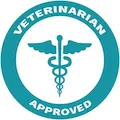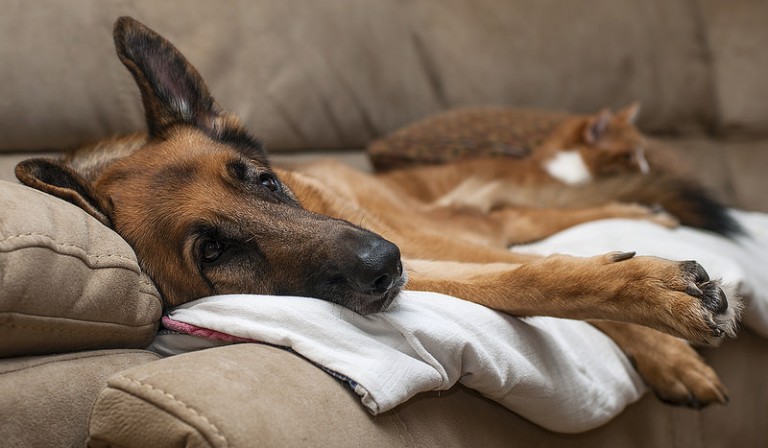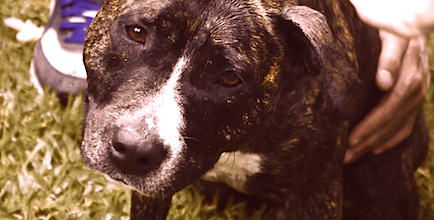Acid Reflux in Dogs — Vague Symptoms, Real Problem
The symptoms of acid reflux in dogs are nonspecific, so it’s important to pay attention to all of the changes in your dog. Read on for more information.

Anyone who has ever suffered from heartburn understands something of the discomfort of acid reflux.
In this condition, stomach acid passes in the wrong way out of the stomach and up into the esophagus (gullet), where it burns the lining, causing pain and discomfort. Dogs can experience this too, and it can be very uncomfortable for them.

Don’t leave your pet’s safety to chance
Sign up for Petful recall alerts today.

Symptoms of Acid Reflux in Dogs
The signs of acid reflux in dogs are vague and non-specific, and include things such as poor appetite, restlessness, gulping a lot and perhaps vomiting.
If the problem goes on for long enough, your dog may lose weight because of his reduced eating.
Rather like assembling a jigsaw puzzle, no one symptom is conclusive that a pet has acid reflux. It is a case of piecing the clues together to see the bigger picture.
What Causes Acid Reflux in Dogs?
Acid reflux happens when the valve at the entrance to the stomach, the gastro-esophageal sphincter, relaxes and acid passes in the wrong direction up into the gullet, or esophagus.
The lining of the esophagus is not designed to cope with caustic acids that burn through the lining, causing inflammation and perhaps even ulceration.
If a dog vomits frequently, the passage of stomach acid going the wrong way can set up the inflammation in the gullet associated with acid reflux. Other reasons include hiatus hernia, where the stomach is positioned farther forward than is usual and puts pressure on the gastric valve.
Likewise, being overweight puts pressure on the stomach and acts like a pair of hands squeezing the stomach and milking acid out. I knew a dog who developed the problem after swallowing a hot potato, which damaged the gastro-esophageal sphincter so that it no longer closed properly.
And finally, when a dog is deeply asleep under general anesthetic, the gastric valve also relaxes. Unless the patient is positioned correctly, acid can leak into the gullet under gravity and set up the symptoms of acid reflux.
Diagnosis: What Does Acid Reflux in Dogs Look Like?
Endoscopy is the best method of establishing a definitive diagnosis. This involves a light general anesthetic and passing an endoscope (a fiberoptic camera) down the patient’s gullet.
An animal suffering from acid reflux has a characteristic reddening and ulceration of the esophageal lining. The vet will also use the opportunity to check the stomach lining to make sure there are no other problems such as a foreign body blocking the gastric valve.
If the signs start immediately after a general anesthetic, there is enough suspicion to warrant treating the patient first before investigating more fully. The good news is that these cases usually improve quickly and can be diagnosed by response to treatment.
If you have ever wondered what an endoscopy for a dog looks like, here’s a video that shows it being performed:
Acid Reflux in Dogs Treatment
In mild cases of acid reflux, sometimes all that is needed is to not feed the dog for 1 or 2 days. This allows the stomach and esophagus to rest and repair itself.
Depending on the severity of the symptoms, treatment is required. This takes 2 forms:
- Correcting any underlying health issue
- And reversing the damage to the esophageal lining
Excellent medicines are available that bind to inflamed tissue to form a soothing bandage layer. Also, anti-acid medications help neutralize stomach acid and limit the damage done by further reflux because of vomiting.
For those dogs who vomit frequently, an investigation to identify and correct the cause is the best course of action. Finally, for overweight dogs whose stomach is pushed forward by fat, weight loss is crucial.
How to Prevent Acid Reflux in Dogs
One tip on how to prevent acid reflux in dogs is that many dogs are prone to vomiting after eating. To help his food stay down, try feeding from a bowl above the dog’s shoulder height. In this position, gravity helps the food slip down into the stomach and stay there. Additionally, helping your dog maintain a healthy weight can also help with prevention.
Frequently Asked Questions (FAQ)
What Foods Cause Acid Reflux in Dogs?
Fatty or acidic foods can be the biggest culprit. Avoid feeding your dog foods high in acidity or fat, such as citrus.
How Long Does Acid Reflux Last in Dogs?
If the dog gets treated promptly for their acid reflux, they can begin to feel better rather quickly, depending on the severity and type of treatment.
What Helps Acid Reflux in Dogs?
How to treat acid reflux in dogs depends on the severity. Sometimes diet changes can help repair the issues, or sometimes medicine is required. If there is underlying health issues causing the reflux, then the help may be more intensive. Consult with your vet for professional help in treating your dog.
Reference
- Small Animal Internal Medicine. Nelson & Couto. Publisher: Mosby. 3rd edition.

This pet health content was written by a veterinarian.








